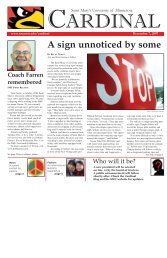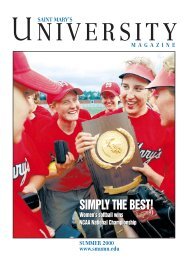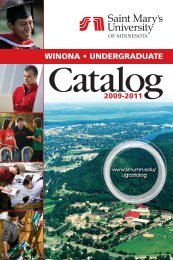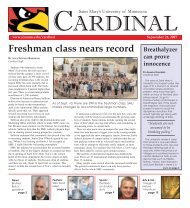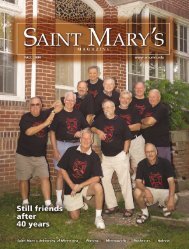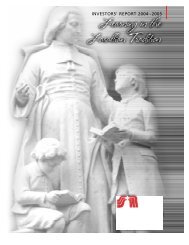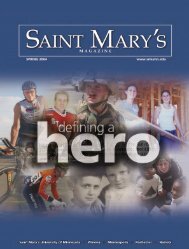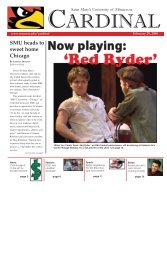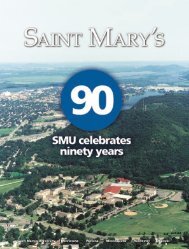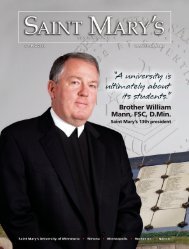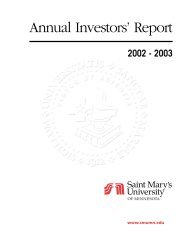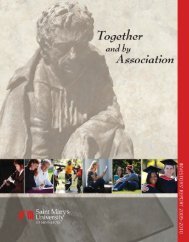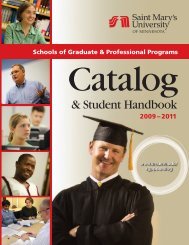PDF version - Saint Mary's University of Minnesota
PDF version - Saint Mary's University of Minnesota
PDF version - Saint Mary's University of Minnesota
You also want an ePaper? Increase the reach of your titles
YUMPU automatically turns print PDFs into web optimized ePapers that Google loves.
Academic Policies & Procedures<br />
When an instructor judges that a student’s behavior is interfering with the learning <strong>of</strong> others or<br />
compromising the instructor’s ability to conduct class in an orderly and respectful manner, the<br />
instructor should warn the student either verbally or by email within 24 hours, making specific reference<br />
to the behavior and the expected correction. Students whose behavior is egregious may be dismissed<br />
from a particular session and asked to leave the classroom immediately; if the student refuses to leave,<br />
the instructor should contact Campus Safety. Repeated incidents from the same student may result in<br />
dismissal from the course (see below).<br />
More serious <strong>of</strong>fenses<br />
Disruptive behaviors which will trigger more severe sanctions include (but again, are not limited to)<br />
use <strong>of</strong> pr<strong>of</strong>anity or other objectionable language; coming to class or lab impaired by the use <strong>of</strong> alcohol<br />
or other substances; theft or sabotage <strong>of</strong> instructional equipment; harassment; verbal, physical, or<br />
emotional abuse; and acts or threats <strong>of</strong> physical violence directed toward oneself or another. These<br />
behaviors will result in the student’s immediate dismissal from the classroom for the duration <strong>of</strong> the<br />
class session, and may result in dismissal from the course. The department chair and the <strong>of</strong>fice <strong>of</strong> the<br />
vice president for academic affairs are to be immediately apprised <strong>of</strong> these cases; where appropriate<br />
(particularly in cases <strong>of</strong> violent behavior or destruction <strong>of</strong> property), the instructor should call Campus<br />
Safety at once, and contact the dean <strong>of</strong> students.<br />
Conditions attributable to physical or psychological disabilities are not considered as a legitimate<br />
excuse for disruptive behavior.<br />
Sanctions and appeals: An instructor who judges a student’s behavior to be intentionally, persistently,<br />
or seriously disruptive <strong>of</strong> the classroom learning environment, or to threaten the well-being <strong>of</strong> the<br />
instructor or another student, should report the incident(s) to the <strong>of</strong>fice <strong>of</strong> the vice president for<br />
academic affairs, together with a description <strong>of</strong> the incident(s) and any intermediate warnings given<br />
to the student. The vice president will then either refer the matter to the dean <strong>of</strong> students, or decide<br />
upon and levy a sanction. This could be a grade penalty for the course reflecting missed work, dismissal<br />
from the course with a grade <strong>of</strong> F, up to dismissal from the university. Students may appeal decisions or<br />
sanctions to the student judicial council under its regular procedures.<br />
Academic Dishonesty<br />
Students at <strong>Saint</strong> Mary’s <strong>University</strong> are expected to maintain the highest standards <strong>of</strong> academic<br />
honesty. Academic dishonesty, in any form, will not be tolerated and will subject the student to<br />
disciplinary sanctions up to and including dismissal. Academic dishonesty comes in a variety <strong>of</strong> forms.<br />
The most common forms are plagiarism, fabrication, abuse <strong>of</strong> internet sources, cheating, and academic<br />
misconduct.<br />
• Plagiarism is the presentation <strong>of</strong> someone else’s words, ideas, or data as one’s own. When a student<br />
submits work for credit that includes the words, ideas, or data <strong>of</strong> others, the source <strong>of</strong> that information<br />
must be acknowledged through complete, accurate, and specific references, as well as quotation<br />
marks if verbatim statements are included. By placing his/her name on work submitted for credit,<br />
the student certifies the originality <strong>of</strong> all work not otherwise identified by appropriate acknowledgments.<br />
Examples <strong>of</strong> plagiarism include: copying someone else’s previously prepared material such<br />
as lab reports, class papers, etc.; copying a paragraph or even sentences from other works, and selfplagiarism<br />
(turning in for new credit your own work from a previous class without authorization).<br />
• Fabrication is the intentional use <strong>of</strong> invented information or the falsification <strong>of</strong> research or other<br />
findings with the intent to deceive. Examples include: the citation <strong>of</strong> information not taken from the<br />
source indicated; submission in a lab report <strong>of</strong> falsified, invented or fictitious data; submitting as the<br />
student’s own work prepared by another, including purchasing or downloading from the Internet,<br />
and falsely representing hours or experience in a field experience or internship.<br />
• Abuse <strong>of</strong> Internet sources is the acquisition or presentation <strong>of</strong> information obtained by purchase<br />
or downloaded for free from the Internet without explicit written acknowledgment <strong>of</strong> the source.<br />
29 29



